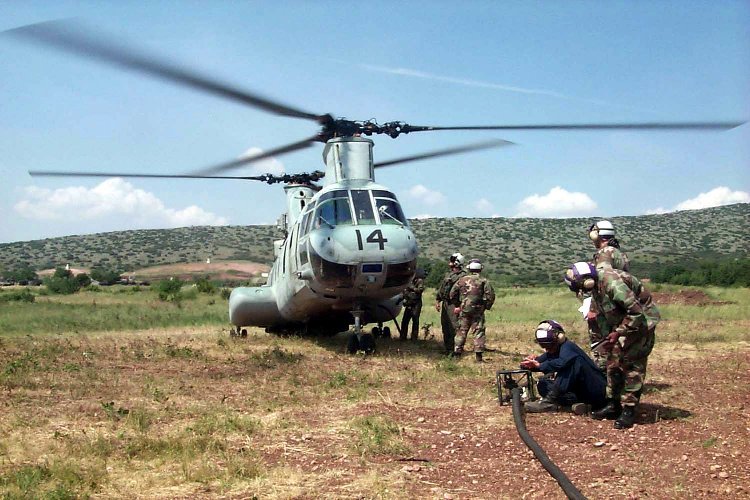|
|
|

MWSS-272 Marines refuel the CH-46E medical evecuation helicopter being flown by Capt. Jason McMeans and Capt. Tim Miller of HMM-266.

To fulfill its expanding
role in contingencies around the globe, the Marine Corps must maintain
its
expeditionary capabilities.
Here at Camp Assiros, Greece, one prime example of the Corps' any-clime-and-place
nature is the Forward Arming and
Refueling Point.
During Exercise Dynamic
Mix 2000, the FARP allows pilots to fly much further from their base of
operations to offer support to ground troops engaged in
simulated combat
at several training areas throughout Greece. Manned almost entirely by
Marine Wing Support Squadron 272, the FARP has 14,000
gallons of fuel
on hand to get helicopters from all nations participating in the NATO exercise
back in the air and on their way quickly.If the situation calls for it,
helos can make a quick return from the battlefields of the field training
exercise area to the east -- where 2d Marine Aircraft Wing
aircraft will support
6th Marines ? to take on enough fuel and ammunition to return to the fight.
The same holds true for helicopters flying in support of the
multi-national battalion
conducting training at Camp Polykastro, Greece, north-east of here.
Every detail is considered
when choosing a site for a FARP, said CWO-3 Oliver Ezell, MWSS-272 fuels
officer. The Okolona, Miss., native was a
member of the survey
team that traveled to Greece prior to the exercise. "We take a look at
the soil, the land, the way the water drains when it rains ?
everything has to
be considered," he said.The potential for danger is a very real part of
any operation or exercise, and extra precautions become crucial for the
safety of military members in the air and on the ground. One of those precautions
is the constant presence of MWSS-272 Crash, Fire and Rescue Marines.
The CFR Marines keep
a close eye on every landing, every take-off and every refuel. "There's
a lot of fuel out there and a lot of tall grass," said Cpl. Jason
Evans, a CFR firefighter,
referring to the gentle slopes of the surrounding Greek countryside. If
needed, the CFR Marines are equipped with 450 pounds
of a powdered firefighting
agent and 150 gallons of flame-smothering foam.
Because of its central
location, the FARP always has a medical evacuation helicopter, a pilot
and a Navy corpsman ready to move out the second they
receive a call for
help from one of the training areas here. Two CFR Marines are also on stand
by, dressed in specialized gear from head to toe, fire
hoses held at the
ready every time such a call comes. "It's our standard operating procedure,"
said Evans. "A call for a (medical evacuation) means
circumstances are
already extreme. We're just there in case something happens."
Whether it's extending
flight capability, hastening the return of air support to ground troops,
or getting help to an injured Marine or NATO troop, the FARP
stands ready. From
CH-53s to German UH-1 search and rescue helicopters, the FARP Marines are
serving all in support of Exercise Dynamic Mix 2000,
highlighting the
Corps' ability to overcome the challenges of any field environment and
integrate seamlessly into a multi-national force.